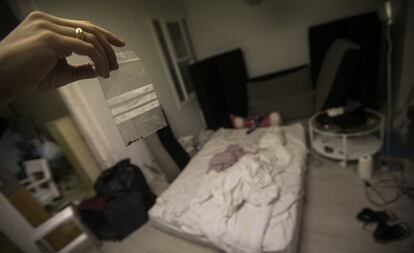The invasion of the bed bug: infestations rise 50% in Madrid
Fumigators say numbers of the parasite are growing thanks to the rise of tourist apartments and a lack of awareness


It was September and 40-year-old Macarena (who didn’t want to use her full name) was not particularly surprised when she found a bite. The next day, her partner woke up furiously scratching his arm. “What is it that has made me this itchy?” he asked. “Don’t scratch and it will stop hurting,” she answered, convinced of what she way saying.
When they realize something is happening, they’re already in the middle of a full-blown infestation
Rentokill spokesperson Jacinto Díez
But bite by bite, Macarena and her partner saw their home invaded by a plague of unknown little black bugs. They lived for seven months with the parasite, which attacked every night, numbing their skin to avoid detection and leaving multiple welts, which itched like hell. Macarena is a lawyer and the daughter of two doctors. She spent months dousing her skin with alcohol to ease the itch and kill possible infections.
Last Wednesday and Thursday, the pest control company Rentokill turned their building upside down. The fumigation was the third Macarena has had to arrange – in fact she does not want to pay the €900 fee for the latest treatment. Her home is in the central area of Malasaña, which, alongside Huertas and Lavapiés, is the neighborhood in Madrid most affected by the plague. Of 19 homes, fumigators have detected bed bugs in 17. In Macarena’s place, the Rentokill workers even lifted up the skirting boards looking for the parasite, which typically hides in pillows, suitcases and clothes.
It is precisely the parasite’s interest in travel bags that has helped them spread. “Five years ago they appeared most of all in hotels. Now, they’re in individual homes,” says Jacinto Díez, the spokesperson for Rentokill, the leading fumigator in Madrid, which among other things, also teaches hotel cleaning professionals how to identify the presence of bed bugs. “People in Madrid are renting out rooms in their apartments without the scheduled fumigation of hotels and this is increasing the number of cases.” In 2015, Rentokill fumigated 240 buildings. Last year, the number jumped to 357 – nearly 50% more.
Malasaña, Huertas and Lavapiés are the neighborhoods in Madrid most affected by the bed bugs
Macarena is a good example of this problem – she herself occasionally rents a room in her house to help pay the mortgage. “The next time I receive a tourist I will fumigate their suitcase. I’m clear on that,” she said.
Lack of awareness is another reason why bed bugs are proliferating. “People tend to say, ‘I have never seen one in my life’,” says Díez. “When they realize something is happening, they’re already in the middle of a full-blown infestation.”
Madrid Town Hall also pays Rentokill to fumigate social housing where bed bugs have been detected. Last year, the City Hall picked up the tab for 150 services.
Up until the Second World War, bed bug infestations were not uncommon. Afterwards though, they began to disappear. “They completely vanished in the 1970s,” explains José María Cámara, a veterinarian in the infestation department at City Hall. “Years ago, university departments asked for bed bug samples to show their students,” adds Díez. But 15 years ago, they made a comeback in Western Europe and the United States. “Their appearance is progressive and continuous,” says Cámara. Madrid City Hall did not have a system to treat the problem until the year 2000.
In Macarena’s building, the fumigation treatment involved a system of heat bubbles to kill both the parasites and their eggs. Rentokill set up a tent to put all the things that could be infected inside and subjected them to high temperatures, like some kind of microwave. In a few days, they will return to review the home. Only then will they know if they have brought an end to Macarena’s nightmare.
Five months without human blood
When Macarena and her partner became aware of the bed bug infestation, they decided to study the enemy. They put them in plastic bags to see how they would survive. Three months later they will still alive. "It's incredible! They never die!," says Macarena.
Bed bugs are a very resilient parasite and can live up to five months without human blood. In one case, it is believed a bed bug lived up to a year and a half without eating. Bed bugs only approach humans to suck their blood and always attack at night. During the day, they hide out in nooks close to the bed. It is difficult to know you are being bitten because the parasite numbs the area it bites. Most people realize they have a bite a while later when they notice the itch.
English version by Melissa Kitson.
Tu suscripción se está usando en otro dispositivo
¿Quieres añadir otro usuario a tu suscripción?
Si continúas leyendo en este dispositivo, no se podrá leer en el otro.
FlechaTu suscripción se está usando en otro dispositivo y solo puedes acceder a EL PAÍS desde un dispositivo a la vez.
Si quieres compartir tu cuenta, cambia tu suscripción a la modalidad Premium, así podrás añadir otro usuario. Cada uno accederá con su propia cuenta de email, lo que os permitirá personalizar vuestra experiencia en EL PAÍS.
¿Tienes una suscripción de empresa? Accede aquí para contratar más cuentas.
En el caso de no saber quién está usando tu cuenta, te recomendamos cambiar tu contraseña aquí.
Si decides continuar compartiendo tu cuenta, este mensaje se mostrará en tu dispositivo y en el de la otra persona que está usando tu cuenta de forma indefinida, afectando a tu experiencia de lectura. Puedes consultar aquí los términos y condiciones de la suscripción digital.
More information
Archived In
Últimas noticias
A survivor’s account of the Interoceanic Train accident: ‘We were scared because of the speed on the curve’
The Interoceanic Train, the Mexican alternative to the Panama Canal
What is known about the Interoceanic Train derailment in Oaxaca
Trump turns a Minnesota fraud allegation into ammunition for his MAGA army against Democrats
Most viewed
- Oona Chaplin: ‘I told James Cameron that I was living in a treehouse and starting a permaculture project with a friend’
- Reinhard Genzel, Nobel laureate in physics: ‘One-minute videos will never give you the truth’
- Why the price of coffee has skyrocketed: from Brazilian plantations to specialty coffee houses
- Pablo Escobar’s hippos: A serious environmental problem, 40 years on
- Chevy Chase, the beloved comedian who was a monster off camera: ‘Not everyone hated him, just the people who’ve worked with him’










































